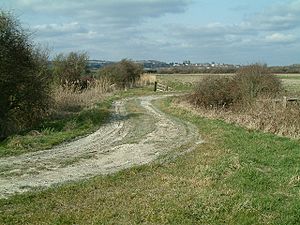Lewes Brooks facts for kids
| Site of Special Scientific Interest | |
 |
|
| Area of Search | East Sussex |
|---|---|
| Interest | Biological |
| Area | 339.1 hectares (838 acres) |
| Notification | 1988 |
| Location map | Magic Map |
Lewes Brooks is a really special natural area in East Sussex, England. It covers about 339.1 hectares, which is like 838 football fields! This amazing place is officially known as a biological Site of Special Scientific Interest, or SSSI for short. It's located just south of the town of Lewes.
This area is where two river valleys meet: the Falmer-Glynde valley and the River Ouse valley. Over many years, the River Ouse has worn away parts of the chalk uplands, leaving behind what are now called the Upper and Lower Rises. These features make Lewes Brooks a unique and important landscape.
Contents
Discover Lewes Brooks
Lewes Brooks is a fantastic example of a flood plain. This means it's a flat area next to a river that sometimes gets covered with water. The land here is made up of many fields. These fields are separated by long, narrow channels of water called ditches. These ditches are super important for the wildlife that lives here.
What is a Special Scientific Interest Site?
A Site of Special Scientific Interest (SSSI) is a special protected area in the United Kingdom. These sites are chosen because they have important wildlife, plants, or geological features. Lewes Brooks is a biological SSSI, which means it's recognized for its amazing plants and animals. Protecting these sites helps keep our natural world healthy.
The Unique Landscape of Lewes Brooks
The landscape of Lewes Brooks is shaped by the River Ouse. This river flows through the area, creating a flood plain. The "Brooks" part of the name refers to these low-lying, wet meadows. The ditches that crisscross the fields are not just for drainage. They create different watery homes for many creatures.
Watery Worlds: Habitats and Environment
The water in the ditches at Lewes Brooks isn't all the same. Some areas have brackish water, which means it's a mix of fresh water and salty water. This happens when the river meets the sea or when tides push saltwater upstream. Other ditches are fed by fresh springs. This mix of water types creates many different habitats.
People also help manage the area by clearing the ditches sometimes. This helps keep the water flowing and creates new spaces for plants and animals to grow. Because of these different water conditions and management, Lewes Brooks has a wide variety of living things.
Incredible Invertebrates: Meet the Wildlife
Lewes Brooks is home to an amazing variety of invertebrates. Invertebrates are animals without backbones, like insects, snails, and worms. This site is especially famous for its diverse invertebrate population. Many rare and interesting species live here.
Busy Beetles and More
You can find many different kinds of water beetles in the ditches. These beetles are important parts of the food web. They help keep the ecosystem balanced. Besides beetles, there are also many types of flies buzzing around. Flies play roles in pollination and as food for other animals.
Snails, Flies, and Moths
Rare snails also make their home in the waters and on the banks of Lewes Brooks. Snails are important decomposers and food sources. The area is also a haven for various moths. Moths are often active at night and are important pollinators. The rich plant life provides food and shelter for all these creatures.
Protecting This Special Place
Lewes Brooks is a vital area for conservation. Its unique mix of habitats supports many species that might not thrive elsewhere. Protecting this site ensures that these special animals and plants can continue to live and flourish. It's a great example of how different environments can support a rich variety of life.

